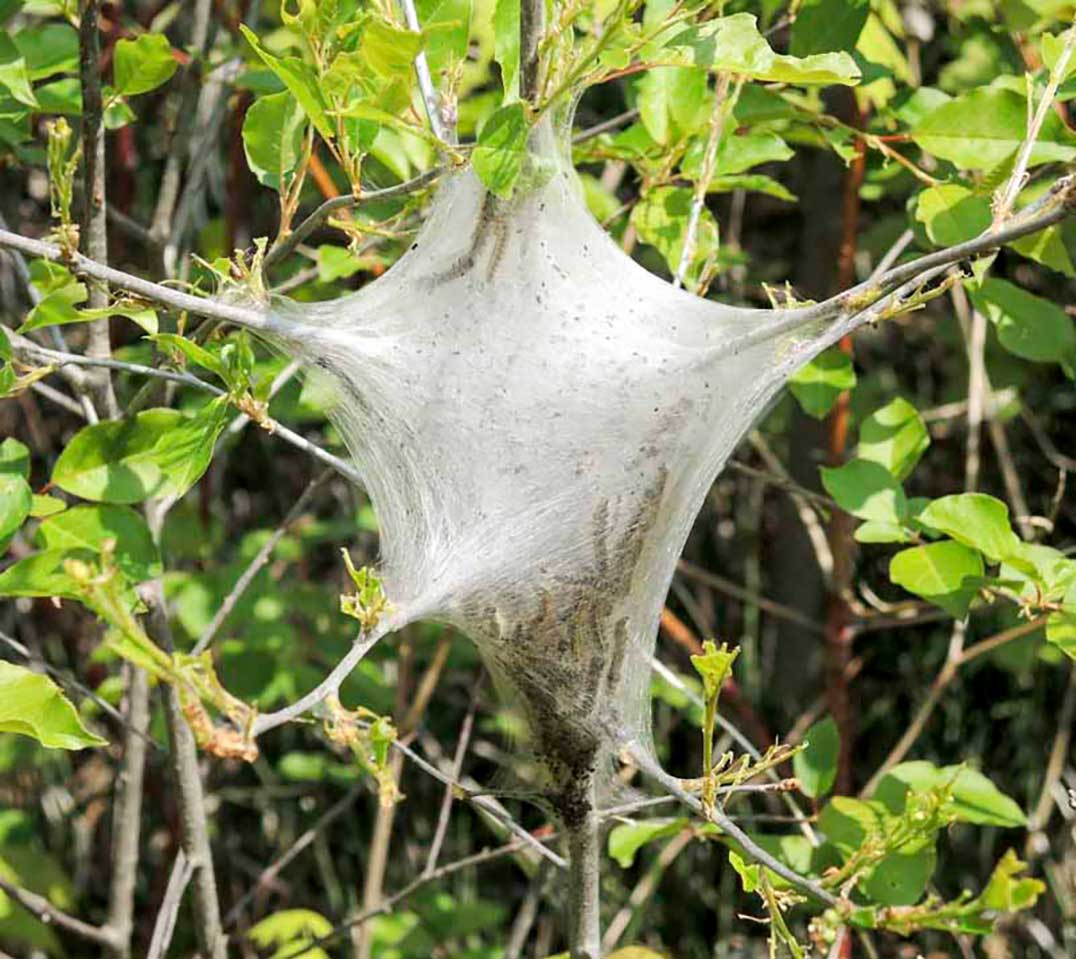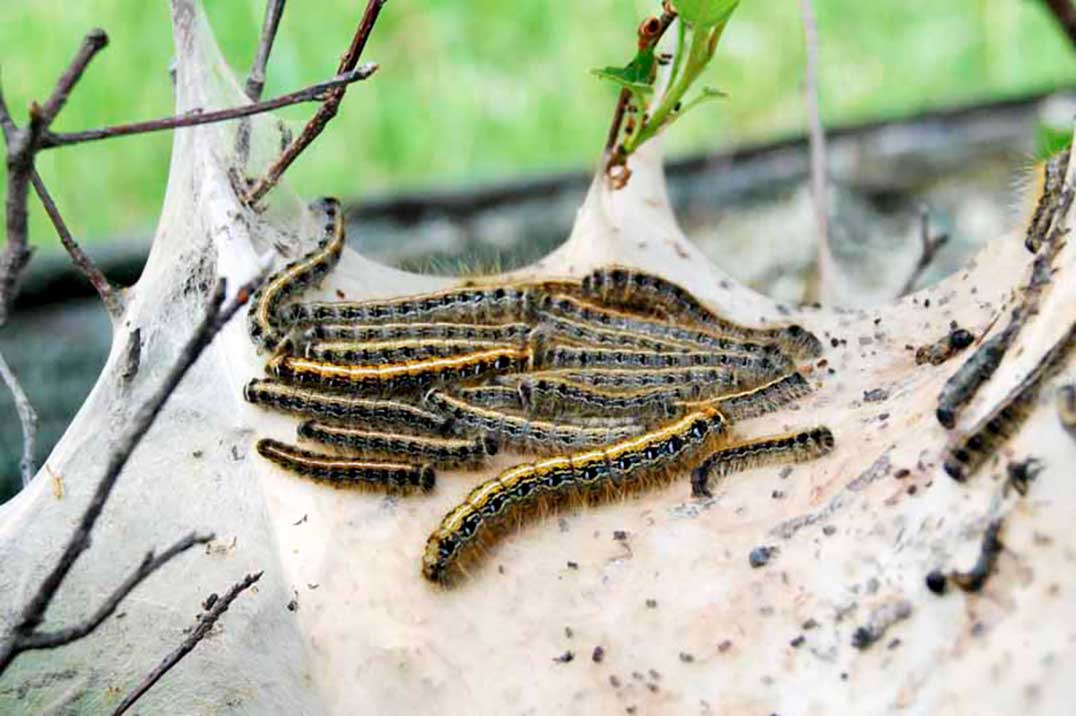MANITOULIN—Driving down Manitoulin roads over the past three weeks, one can’t help but see clusters of unsightly silken tents on the shrubs growing in open areas. These tents are made by the caterpillars of moths called eastern tent caterpillars.
Tents are an important part of the biology of this insect and in most cases the caterpillars that spend part of their days living within them, feed on the leaves of shrubs and trees without causing too much damage. However, when teeming caterpillars are found scrambling over the tents and along nearby branches of shrubs and trees in your gardens or farms, some means of control should be attempted.
There are two kinds of tent caterpillars on Manitoulin Island and both are native. The eastern tent caterpillar, with the scientific name Malacosoma americanum, is common this spring and makes the conspicuous tents.
The second species is the forest tent caterpillar with the scientific name Malacosoma distria. This species does not make tents and prefers to feed on aspen poplar and birch. It is currently uncommon on the Island and tends to have irruptive populations about every 12-14 years when their caterpillars strip all the leaves off trees. However, as is often nature’s way, defoliation rarely kills the trees; new leaves appear soon after the caterpillars finish feeding.

The two species are closely related, but their feeding behaviour is different. The eastern tent caterpillar, in contrast to the forest tent caterpillar, prefers to feed on shrubs such as wild cherry, chokecherry, apple and crabapple. Weaker shrubs sometimes succumb to defoliation, but in most cases the defoliation occurs earlier enough in the spring that the shrub can recover.
The caterpillars of both species have one generation per year and overwinter in the egg stage. Eggs are laid in masses that encircle smaller twigs of the host plant. The masses are about the size of the eraser and metal part of a pencil, contain 150-350 eggs, and the surface appears varnished.
Eastern tent caterpillars hatch from eggs in the spring about the time host leaves begin to unfold. The young, hairy caterpillars gather at a fork or crotch and begin to build a silken web from which they move to feed on new leaves.
Silk is made by spinnerets on their heads and as the caterpillars grow, the web becomes a diamond-shaped tent in which the caterpillars rest.

basking on their tent.
Tents are vital for the survival of eastern tent caterpillars and have several functions. Tents facilitate basking, offer some protection from enemies, provide secure sites for hanging on, and act as a staging site from which the caterpillars launch en masse forays to distant feeding sites.
Tents are also used for regulating the body temperatures of caterpillars allowing them to warm more quickly than they would if they remained outside. They are typically oriented with the broadest wall facing the southeast so the caterpillars can bask in the morning sun. Caterpillars typically pack tightly together when basking to reduce heat loss caused by wind currents.
Tents act as miniature greenhouses by trapping heat of the sun. The caterpillars then adjust their body temperatures by moving to warmer or cooler compartments. They usually rest in a tight cluster just under a sunlit surface of the tent on cool mornings where the temperature can be as much as 20°C warmer than the surrounding air temperature.
Caterpillars feed three times each day, just before dawn, at midafternoon, and in the evening after sunset. During each bout of feeding, the caterpillars emerge from the tent, add silk to the structure, move to distant feeding sites, and then return immediately to the tent where they rest until the next activity period. The oldest caterpillars feed at night and rest during the day.
Silk is also laid down as the caterpillars leave the tents to forage for food. These trails of silk also serve as a guide for others to the food source and as markers for the return trip. When populations are large, entire shrubs or trees can become covered with silk webbing.
Full grown caterpillars are about 50 mm long with a black head and body, a white stripe down the back and a series of bright blue spots between longitudinal yellow lines. They vigourously thrash the anterior half of their bodies when they detect predators or parasites which is thought to deter attacks. Few species of birds find the hairy caterpillars palatable.
Of interest, leaves of cherry are known to contain cyanide and the caterpillars are known to regurgitate cyanide-laden juices when disturbed. In addition, the eastern tent caterpillar is toxic to horses and can cause pregnant mares to abort.
Once finished feeding, full grown caterpillars leave the host plant to spin white cocoons on fences, under fallen branches, debris or tree trunks. The reddish brown moths appear in 2-3 weeks, mate and lay eggs. They and are strictly nocturnal and only fly after midnight. Adult moths do not feed and die soon after mating and laying eggs.
In most years, populations of eastern tent caterpillars are reduced by natural enemies such as parasitic wasps, tachinid flies, spiders, ants, and diseases. However, when their numbers are high, an attempt at control can take place in the winter after the leaves have fallen and the egg masses are prominent. Egg masses at this time can be scrapped off the twigs with a knife.
Tearing down the protective tents by hand is effective as is clipping the branches with tents and burning them. Small tents in the early spring can be destroyed by pulling them apart with thick gloves. This should be done on rainy or cool days when the caterpillars are inside the tents and not outside feeding on foliage.
Tents in urban gardens can be removed by strong water spray from a garden hose. As a last resort, foraging caterpillars or those basking on their tents, can be sprayed with Bt (Bacillus thuringiensis, a naturally occurring soil bacteria that kills caterpillars) and available at hardware stores.



